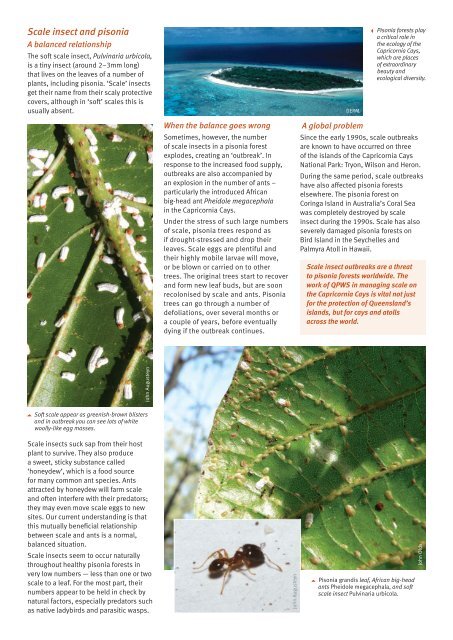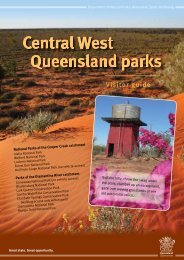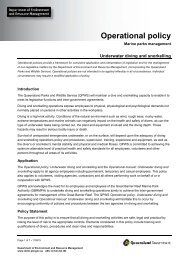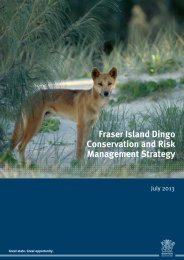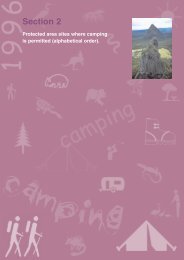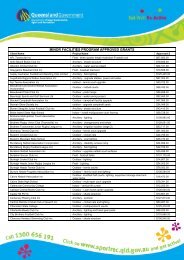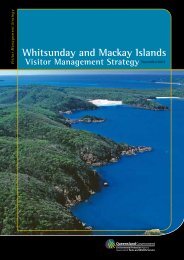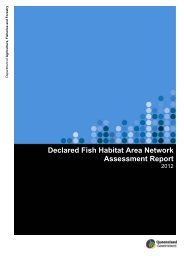Managing scale insect outbreaks in the Capricornia Cays
Managing scale insect outbreaks in the Capricornia Cays
Managing scale insect outbreaks in the Capricornia Cays
You also want an ePaper? Increase the reach of your titles
YUMPU automatically turns print PDFs into web optimized ePapers that Google loves.
Scale <strong><strong>in</strong>sect</strong> and pisonia<br />
A balanced relationship<br />
The soft <strong>scale</strong> <strong><strong>in</strong>sect</strong>, Pulv<strong>in</strong>aria urbicola,<br />
is a t<strong>in</strong>y <strong><strong>in</strong>sect</strong> (around 2–3mm long)<br />
that lives on <strong>the</strong> leaves of a number of<br />
plants, <strong>in</strong>clud<strong>in</strong>g pisonia. ‘Scale’ <strong><strong>in</strong>sect</strong>s<br />
get <strong>the</strong>ir name from <strong>the</strong>ir scaly protective<br />
covers, although <strong>in</strong> ‘soft’ <strong>scale</strong>s this is<br />
usually absent.<br />
DERM<br />
Pisonia forests play<br />
a critical role <strong>in</strong><br />
<strong>the</strong> ecology of <strong>the</strong><br />
<strong>Capricornia</strong> <strong>Cays</strong>,<br />
which are places<br />
of extraord<strong>in</strong>ary<br />
beauty and<br />
ecological diversity.<br />
When <strong>the</strong> balance goes wrong<br />
Sometimes, however, <strong>the</strong> number<br />
of <strong>scale</strong> <strong><strong>in</strong>sect</strong>s <strong>in</strong> a pisonia forest<br />
explodes, creat<strong>in</strong>g an ‘outbreak’. In<br />
response to <strong>the</strong> <strong>in</strong>creased food supply,<br />
<strong>outbreaks</strong> are also accompanied by<br />
an explosion <strong>in</strong> <strong>the</strong> number of ants –<br />
particularly <strong>the</strong> <strong>in</strong>troduced African<br />
big-head ant Pheidole megacephala<br />
<strong>in</strong> <strong>the</strong> <strong>Capricornia</strong> <strong>Cays</strong>.<br />
Under <strong>the</strong> stress of such large numbers<br />
of <strong>scale</strong>, pisonia trees respond as<br />
if drought-stressed and drop <strong>the</strong>ir<br />
leaves. Scale eggs are plentiful and<br />
<strong>the</strong>ir highly mobile larvae will move,<br />
or be blown or carried on to o<strong>the</strong>r<br />
trees. The orig<strong>in</strong>al trees start to recover<br />
and form new leaf buds, but are soon<br />
recolonised by <strong>scale</strong> and ants. Pisonia<br />
trees can go through a number of<br />
defoliations, over several months or<br />
a couple of years, before eventually<br />
dy<strong>in</strong>g if <strong>the</strong> outbreak cont<strong>in</strong>ues.<br />
A global problem<br />
S<strong>in</strong>ce <strong>the</strong> early 1990s, <strong>scale</strong> <strong>outbreaks</strong><br />
are known to have occurred on three<br />
of <strong>the</strong> islands of <strong>the</strong> <strong>Capricornia</strong> <strong>Cays</strong><br />
National Park: Tryon, Wilson and Heron.<br />
Dur<strong>in</strong>g <strong>the</strong> same period, <strong>scale</strong> <strong>outbreaks</strong><br />
have also affected pisonia forests<br />
elsewhere. The pisonia forest on<br />
Cor<strong>in</strong>ga Island <strong>in</strong> Australia’s Coral Sea<br />
was completely destroyed by <strong>scale</strong><br />
<strong><strong>in</strong>sect</strong> dur<strong>in</strong>g <strong>the</strong> 1990s. Scale has also<br />
severely damaged pisonia forests on<br />
Bird Island <strong>in</strong> <strong>the</strong> Seychelles and<br />
Palmyra Atoll <strong>in</strong> Hawaii.<br />
Scale <strong><strong>in</strong>sect</strong> <strong>outbreaks</strong> are a threat<br />
to pisonia forests worldwide. The<br />
work of QPWS <strong>in</strong> manag<strong>in</strong>g <strong>scale</strong> on<br />
<strong>the</strong> <strong>Capricornia</strong> <strong>Cays</strong> is vital not just<br />
for <strong>the</strong> protection of Queensland’s<br />
islands, but for cays and atolls<br />
across <strong>the</strong> world.<br />
John Augusteyn<br />
Soft <strong>scale</strong> appear as greenish-brown blisters<br />
and <strong>in</strong> outbreak you can see lots of white<br />
woolly-like egg masses.<br />
Scale <strong><strong>in</strong>sect</strong>s suck sap from <strong>the</strong>ir host<br />
plant to survive. They also produce<br />
a sweet, sticky substance called<br />
‘honeydew’, which is a food source<br />
for many common ant species. Ants<br />
attracted by honeydew will farm <strong>scale</strong><br />
and often <strong>in</strong>terfere with <strong>the</strong>ir predators;<br />
<strong>the</strong>y may even move <strong>scale</strong> eggs to new<br />
sites. Our current understand<strong>in</strong>g is that<br />
this mutually beneficial relationship<br />
between <strong>scale</strong> and ants is a normal,<br />
balanced situation.<br />
Scale <strong><strong>in</strong>sect</strong>s seem to occur naturally<br />
throughout healthy pisonia forests <strong>in</strong><br />
very low numbers — less than one or two<br />
<strong>scale</strong> to a leaf. For <strong>the</strong> most part, <strong>the</strong>ir<br />
numbers appear to be held <strong>in</strong> check by<br />
natural factors, especially predators such<br />
as native ladybirds and parasitic wasps.<br />
John Augusteyn<br />
Pisonia grandis leaf, African big-head<br />
ants Pheidole megacephala, and soft<br />
<strong>scale</strong> <strong><strong>in</strong>sect</strong> Pulv<strong>in</strong>aria urbicola.<br />
John Olds


